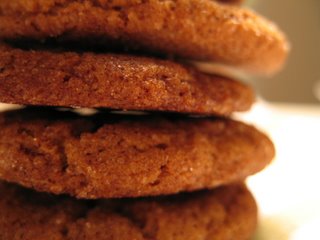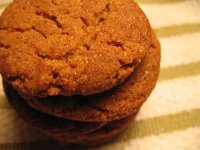 I'm a bread and butter kind of girl. Cooking and eating fancy meals is just dandy for special occasions, but what I'm really interested in is what people eat every day. I like to keep it simple and keep it good. Good food doesn't need to take 10 hours to prepare or call for a million ingredients or use expensive spices in order to be good. You don't even need to be a master chef in order to make it good. You just need to want it to be good.
I'm a bread and butter kind of girl. Cooking and eating fancy meals is just dandy for special occasions, but what I'm really interested in is what people eat every day. I like to keep it simple and keep it good. Good food doesn't need to take 10 hours to prepare or call for a million ingredients or use expensive spices in order to be good. You don't even need to be a master chef in order to make it good. You just need to want it to be good.Two years ago, I didn't know how to cook. The Engineer and I subsisted on stir-fries and rice, pasta and jar sauce, and runs to Anna's Taqueria for burritos. Then I started doing WeightWatchers. And I realized that eating well was really boring. No flavor. No feeling of being full. No satisfaction of any kind. I felt that the only choice being offered was between eating what tasted good and being 'ok' with the portly consequences or eating boring food and staying healthy-thin. I felt miserable and trapped and angry.
And that's how cooking became my rebellion. I wanted my food to be good. I wanted it to taste good and be good for me at the same time. I wanted this in a way that I felt in my gut and my heart. I absolutely did not believe that my only choice was between good-tasting food and good-for-you food. So I started to cook.
Two years later, I have a lot more confidence in the kitchen. I try new recipes as I come across them and will reincarnate recipes to my own tastes if I think the original had potential. I know where I can cut corners and use low-fat ingredients, but add a few 'regular' ingredients to bring out a good balance of flavor. And I've loosened up a lot. I'm a recovering perfectionist and it's still hard to try a new ingredient without knowing how it will taste or not feel like a failure if a recipe doesn't turn out brilliantly.
I've also worked on expanding my portfolio of "Tastes That I Like." In a recent interview with Seth Roberts on The Restaurant Guys (Click HERE to download the interview), Roberts mentions that Americans tend more and more to eat foods with the same flavors. Walk into any fast food burger joint in the US and order any burger and I guarantee that it taste pretty much like any other burger you would order anywhere. On top of that, Roberts says that people tend to eat the same basic foods with the same basic flavors over and over again--their daily diets don't change. Although Roberts didn't go into this in his interview, what this tells me is that a lot of people out there are no longer really able to recognize what tastes good; they only recognize what is familiar.
When I first started cooking, I was only able to recognize when I didn't like something that I ate--it was too bland or too over-cooked, etc.--but I couldn't identify what was missing or how to make it better. It took a lot of trial and error in order for to figure out what flavors I liked, how much of a particular flavor was good, and what flavors went together. Chefs and foodies call this 'expanding your palate.' I'm still figuring this out and have gotten more adventurous about trying new combinations of ingredients and spices (Lemon-Anise Muffin recipe coming soon!).
So, bread and butter. When I was in college, my dad sent me a post card that said, "To simplify, you have to say no." That post card has hung next to every desk I've had since and I often think about it when I'm in decision-making situations--whether that situation is what to wear in the morning, how to handle a new project, or what ingredients to add in my soup. Simplify. Keep it simple and keep it good, that's how I roll.
-----
Oven-Roasted Vegetables
small red or white potatoes (2" - 3" across)--estimate about 2 potatoes per person plus one for the cook--halved and quartered
1 large onion--cut into wedges
1 red pepper--cut into chunks
1 zucchini/eggplant/summer squash--cut into chunks
Salt to taste
Thyme, rosemary and/or oregano to taste
Note: The potatoes should be cooked separately from the other veggies. Not only do they take longer, but other veggies tend to release water as they bake, which prevents the potatoes from crisping. If baking both potatoes and veggies, put the potatoes in the oven 10-20 minutes before the other veggies so both trays will be ready at the same time.
Preheat oven to 425 degrees.
Potatoes: Put the potatoes into a bowl by themselves. Drizzle 1 tablespoon of olive oil over the potatoes. Add 1 teaspoon of sea salt and 1 teaspoon of dried thyme, rosemary, or oregano (or any combination of these herbs equalling about 1 tsp). If using fresh herbs, increase the amount by 1/2 to 1 tsp. Line a baking sheet with aluminum foil, spray with non-stick coating, and spread potatoes over sheet. Bake for 40-50 minutes until browned and crisp, stirring occasionally to prevent the potatoes from sticking.
Other veggies: Combine the other veggies in a separate bowl, drizzle with 1 tablespoon of olive oil and add herbs. Line a second baking sheet with aluminum foil, spray with non-stick coating, and arrange veggies. Bake for about 30 minutes, stirring occasionally, until onions are crisp at the edges and caramelized, and the other veggies are cooked through.
Combine veggies and potatoes, adjust spices to taste, and serve!
WeightWatchers: Small potatoes are about 1 point each. One tablespoon of olive oil is 3 points. If cooking with 8 potatoes and 2 tablespoons of olive oil (total--one tablespoon for each bowl), the total points for the entire mess o' veggies is about 10. In other words, this is a very WeightWatcher's friendly meal or side-dish! I usually combine about 1 cup of roasted veggies (about 1 point) and 3/4 cup of rice (3 points) for a more satisfying meal.













































